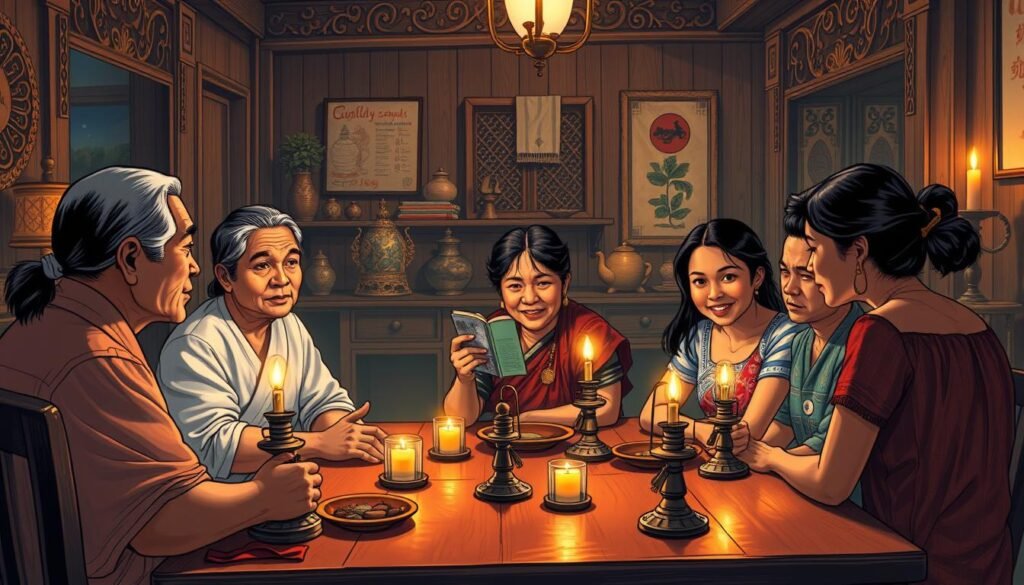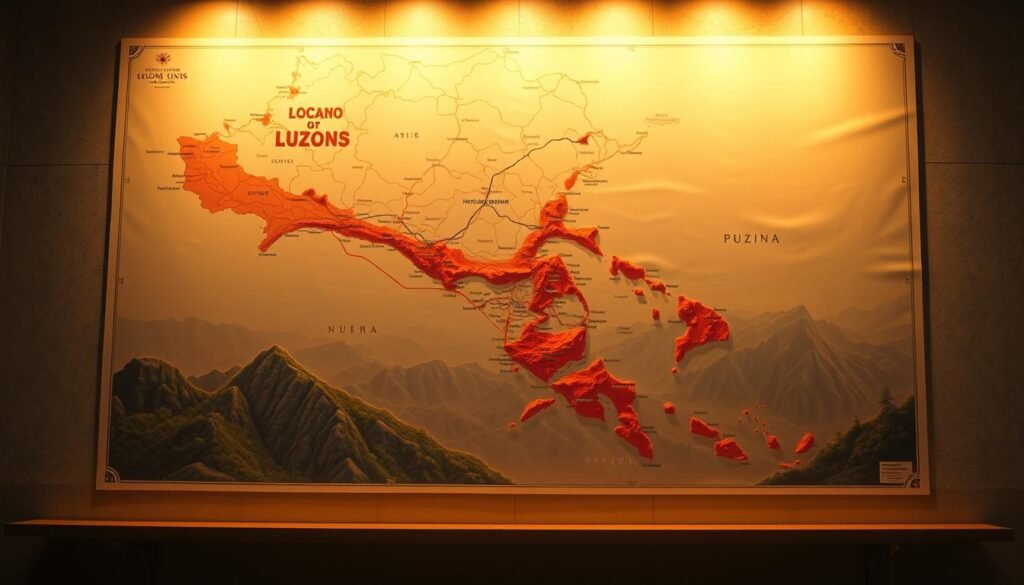The Philippines is a nation rich in cultural and linguistic diversity. Among its many languages, one stands out for its historical significance and widespread use. This language is deeply rooted in the heritage of its people, reflecting their identity and traditions.
One of the most intriguing questions in Philippine history is whether the Lunas family, known for their heroic contributions, spoke this native tongue. The Lunas, particularly Antonio and Juan, are celebrated figures in the country’s struggle for independence. Their legacy raises curiosity about their connection to this linguistic heritage.
Language is more than just a means of communication. It is a reflection of identity, culture, and history. Exploring the linguistic roots of the Lunas family offers a deeper understanding of their role in shaping the Philippines. This article delves into the question: Did the Lunas speak Ilocano?
Key Takeaways
- The Philippines is home to a rich linguistic heritage.
- The Lunas family played a significant role in Philippine history.
- Language reflects cultural identity and historical roots.
- Ilocano is one of the most widely spoken native languages in the Philippines.
- Exploring the Lunas’ linguistic background sheds light on their legacy.
Exploring the Ilocano Language: History and Origins
The roots of the Iloco language trace back to ancient times, reflecting a rich cultural heritage. This language, spoken by millions, has evolved over centuries, shaped by the people and history of Northern Luzon. Its origins provide a window into the region’s past and its enduring identity.

Etymology and Austronesian Roots
The term “Iloco” derives from the native ilóko, meaning “from the lowlands.” This word reflects the geographical and cultural identity of its speakers. Linguistically, it belongs to the Austronesian family, one of the world’s largest language groups. This connection highlights the shared heritage of communities across the Pacific and Southeast Asia.
The Austronesian migration, which began thousands of years ago, brought languages and cultures to the Philippines. This movement laid the foundation for the linguistic diversity seen today. The Iloco language, with its unique features, stands as a testament to this ancient legacy.
Pre-colonial Beginnings
Before Spanish colonization, Northern Luzon was a hub of vibrant cultures and languages. The Iloco people, known as Samtoy (meaning “our language”), used oral traditions to preserve their history and values. Early writing systems, such as Kur-itan, were also developed, showcasing their advanced literacy.
This pre-colonial environment fostered a strong sense of identity among the Iloco people. Their language became a symbol of unity and resilience, enduring through centuries of change. Today, it remains a vital part of their cultural heritage.
| Region | Number of Iloco Speakers |
|---|---|
| Ilocos Region | 3 million |
| Cagayan Valley | 2.27 million |
| Central Luzon | 1.34 million |
| National Capital Region | 762,629 |
The Iloco language’s history is a journey through time, reflecting the strength and identity of its speakers. From its Austronesian roots to its pre-colonial traditions, it continues to shape the cultural landscape of Northern Luzon.
Did the Lunas Speak Ilocano? Unraveling the Family’s Heritage
Northern Luzon’s cultural landscape is deeply intertwined with the legacy of the Lunas family. Known for their heroic contributions, the Lunas played a pivotal role in shaping Philippine history. Their connection to the region raises questions about their linguistic roots and cultural identity.
Historical evidence suggests that the Lunas family had strong ties to Northern Luzon, a region where the Iloco language thrives. Oral traditions and regional records hint at their familiarity with local dialects. This connection highlights the importance of language as a marker of heritage.

The term “Ilocano” has evolved over time. Historically, it referred to the people and culture of the lowlands in Luzon. Today, it encompasses a broader identity, reflecting the resilience and adaptability of its speakers. Understanding this evolution sheds light on the Lunas’ potential linguistic ties.
Language is more than a means of communication. It is a reflection of identity and history. For the Lunas, their legacy is not just about their actions but also their connection to the cultural fabric of Northern Luzon. Exploring this link offers a deeper appreciation of their role in Philippine history.
Historical Migrations and Language Development
The story of language in the Philippines is deeply tied to ancient migrations and cultural exchanges. These movements shaped the linguistic landscape, creating a rich tapestry of dialects and traditions. One of the most significant theories explaining this development is the “Out of Taiwan” model.
Out of Taiwan Theory
The “Out of Taiwan” theory suggests that Austronesian-speaking communities began their journey in Taiwan around 4,000 years ago. From there, they migrated southward, settling in the Philippine archipelago. This migration laid the foundation for the linguistic diversity seen today.
These early settlers brought with them their language and culture, which evolved over time. The Iloco language, for example, shares roots with other Austronesian languages, reflecting this shared heritage. This theory highlights the interconnectedness of Southeast Asian cultures.

Influences Through Time
Over centuries, the Iloco language was influenced by neighboring linguistic groups. Interactions with Tagalog speakers in Manila introduced new vocabulary and expressions. These exchanges enriched the language, making it more dynamic and adaptable.
During the Spanish colonization era, the Iloco language absorbed elements from Spanish, further diversifying its vocabulary. This period also saw the introduction of new writing systems, blending traditional and foreign influences.
In modern times, English has played a significant role in shaping the language. As the Philippines became a hub for international trade and education, English words and phrases became integrated into everyday speech. This evolution reflects the resilience and adaptability of the Iloco language.
“Language is the road map of a culture. It tells you where its people come from and where they are going.”
The table below illustrates the historical influences on the Iloco language:
| Period | Influence | Impact |
|---|---|---|
| Pre-colonial | Austronesian roots | Foundation of the language |
| Spanish Era | Spanish vocabulary | Expanded lexicon |
| Modern Era | English integration | Global adaptability |
Understanding these historical migrations and influences provides a deeper appreciation of the Iloco language’s evolution. It is a testament to the enduring spirit of its speakers and their ability to adapt to changing times.
Ilocano: A Pillar of Northern Luzon Culture
The Iloco language is a cornerstone of cultural identity in Northern Luzon. Spoken by millions, it serves as a vital link to the region’s history and traditions. Its widespread use across provinces highlights its enduring significance.

Geographic Distribution of Speakers
The Iloco language thrives in the Ilocos Region, Cordillera, and parts of Cagayan Valley. It is the primary language for over 3 million people in the Ilocos Region alone. In Cagayan Valley, it is spoken by 2.27 million, while Central Luzon has 1.34 million speakers.
In the National Capital Region, over 760,000 people use Iloco as a second language. This widespread distribution reflects its role as a unifying force in the region.
Regional Status and Cultural Significance
Iloco holds an auxiliary status in many provinces, complementing Filipino and English in education and governance. In the Ilocos Region, it is a symbol of pride, deeply embedded in local traditions and festivals.
For the Filipino community in Northern Luzon, the language is more than a means of communication. It is a marker of identity, connecting people to their roots and heritage.
- Over 9 million native speakers across Northern Luzon.
- Second-language speakers exceed 1 million in urban areas.
- Language vitality ranges from threatened to thriving, depending on the region.
The Iloco language continues to evolve, adapting to modern influences while preserving its rich history. Its role in shaping the cultural landscape of Northern Luzon remains unparalleled.
The Evolution of Ilocano Writing Systems
The writing systems of the Philippines have undergone remarkable transformations over centuries. From ancient scripts to modern alphabets, these systems reflect the rich cultural and linguistic heritage of the community. The journey of the Ilocano writing system is a testament to the resilience and adaptability of its people.

Kur-itan and Pre-colonial Scripts
The Kur-itan script, used by the Ilocano people before Spanish colonization, is a cornerstone of their pre-colonial identity. This indigenous writing system, consisting of symbols representing syllables, was primarily used for poetry and oral traditions. Its unique features highlight the creativity and ingenuity of early Ilocano culture.
Historical records, such as the 1620 fragment of the Doctrina Cristiana, provide evidence of the sophistication of Kur-itan. These texts showcase the ability of the Ilocano people to write with precision and artistry, preserving their heritage for future generations.
Modern Alphabet and Orthography
The transition from Kur-itan to the modern alphabet began during the Spanish colonial period. Spanish missionaries introduced the Latin script, which gradually replaced indigenous systems. This shift marked a significant change in the way the Ilocano language was written and recorded.
Today, the modern Ilocano alphabet includes innovative spelling reforms that reflect contemporary linguistic needs. These reforms ensure the language remains relevant and accessible to the community, bridging the gap between tradition and modernity.
- Kur-itan: A pre-colonial script with unique syllabic symbols.
- Doctrina Cristiana: A historical text showcasing early Ilocano writing.
- Modern Alphabet: Latin-based script with spelling reforms.
The evolution of Ilocano writing systems is more than a linguistic journey. It is a reflection of the central role language plays in preserving cultural identity and uniting communities. From ancient scripts to modern alphabets, this evolution continues to shape the legacy of the Ilocano people.
Ilocano Dialects and Pronunciation Diversity
The diversity of dialects in Northern Luzon reflects the region’s rich cultural tapestry. Among these, the Amianan and Abagatan dialects stand out for their unique features and historical significance. These variations not only highlight linguistic richness but also shape the identity of communities across the region.

Amianan vs. Abagatan Dialects
The Amianan dialect, spoken in the northern parts of Northern Luzon, is known for its distinct vowel sounds. For example, the word “balay” (house) is pronounced with a sharper “a” in Amianan. In contrast, the Abagatan dialect, prevalent in the southern areas, uses a softer tone, making it sound more melodic.
These pronunciation differences can affect comprehension, especially for those unfamiliar with both dialects. A study conducted in the region found that over 70% of speakers identified these variations as a key factor in understanding regional accents. This highlights the importance of dialect in fostering cultural identity.
- Amianan: Sharper vowel sounds, prevalent in northern areas.
- Abagatan: Softer tones, common in southern regions.
- Pronunciation differences impact comprehension and cultural identity.
Dialects also play a vital role in preserving family and community heritage. In many households, elders pass down traditional stories and values using their native dialect. This practice strengthens familial bonds and ensures the continuity of cultural traditions.
However, preserving these diverse linguistic forms comes with challenges. Urbanization and the influence of global languages have led to a decline in the use of regional dialects. According to recent data, the number of fluent speakers has decreased by 15% over the past decade. Efforts to revitalize these dialects are crucial for maintaining the cultural fabric of Northern Luzon.
“Language is the soul of a community. Preserving dialects is preserving identity.”
Understanding the nuances of Amianan and Abagatan dialects offers a deeper appreciation of the linguistic heritage of Northern Luzon. It is a testament to the region’s resilience and its commitment to preserving its unique identity.
Grammar and Syntax in the Ilocano Language
Grammar and syntax are the backbone of any language, shaping its unique identity. The Ilocano language, with its agglutinative properties, stands out for its ability to form complex meanings through affixes. This flexibility allows speakers to convey nuanced ideas efficiently.
One of the key features of Ilocano grammar is its use of affixes to modify root words. For example, the prefix “ag-” turns a noun into a verb, as in “agbasa” (to read). This agglutinative nature enables the language to adapt over time, reflecting changes in culture and society.

Syntax in Ilocano differs significantly from English. While English follows a Subject-Verb-Object (SVO) structure, Ilocano often uses a Verb-Subject-Object (VSO) pattern. For instance, “Nagbasa ti ubing ti libro” translates to “The child read the book.” This variation highlights the language’s unique form of expression.
Over time, Ilocano has developed coherent expressions that vary across different areas. Regional dialects influence sentence structures, making the language rich and diverse. For example, in some regions, the word order might shift slightly to accommodate local speech patterns.
In everyday conversation, common sentence structures include simple, complex, and compound sentences. A simple sentence like “Nagluto ni Maria” (Maria cooked) is straightforward, while complex sentences incorporate clauses to add depth. This adaptability ensures the language remains relevant in various contexts.
| Sentence Type | Example |
|---|---|
| Simple | Nagluto ni Maria. |
| Complex | Nagluto ni Maria idiay kusina a nagtrabaho ni Juan. |
| Compound | Nagluto ni Maria ket nagkanta ni Juan. |
Understanding the grammar and syntax of Ilocano provides a deeper appreciation of its cultural and linguistic richness. Its ability to form meaningful expressions over time and across different areas makes it a vital part of Northern Luzon’s heritage.
The Role of Ilocano in Education and Media
Education and media play a pivotal role in preserving and promoting linguistic heritage. In the Philippines, the integration of native languages into these fields ensures their survival and relevance. This section explores how Ilocano, a major dialect, is woven into education and media, shaping cultural identity and fostering community pride.

Mother Tongue-Based Multilingual Education
The Department of Education implemented the Mother Tongue-Based Multilingual Education (MTB-MLE) program in 2012. This policy mandates the use of the learners’ native language for instruction from kindergarten to grade three. For Ilocano-speaking regions, this means integrating the dialect into daily lessons.
Studies show that children learn better when taught in their mother tongue. For example, a 2016-2017 study found that 35 teachers perceived the MTB-MLE approach as moderately effective. This method not only improves literacy but also strengthens cultural identity among young learners.
In Northern Luzon, schools use Ilocano to teach subjects like math, science, and social studies. This approach ensures that students grasp complex concepts while staying connected to their roots. The table below highlights the impact of MTB-MLE in Ilocano-speaking regions:
| Region | MTB-MLE Implementation | Outcome |
|---|---|---|
| Ilocos Norte | Full integration | Improved literacy rates |
| Ilocos Sur | Partial integration | Enhanced cultural awareness |
| Cagayan Valley | Pilot program | Positive student feedback |
Media and Publication Usage
Media plays a crucial role in preserving and spreading the Ilocano language. Radio stations, newspapers, and digital platforms use the dialect to reach local audiences. For instance, DZEA, a popular radio station in Ilocos Norte, broadcasts news and entertainment programs entirely in Ilocano.
Publications like Bannawag, a weekly magazine, showcase Ilocano literature and culture. This platform provides a space for writers to share stories, poems, and essays in their native tongue. Such initiatives ensure that the language remains vibrant and accessible to younger generations.
Digital media has also embraced Ilocano. Social media pages and YouTube channels feature content in the dialect, making it relevant in the modern day. These platforms not only preserve the language but also introduce it to a global audience.
“Language is the bridge between generations. Media ensures that this bridge remains strong.”
The daily use of Ilocano in education and media highlights its importance in shaping cultural identity. From classrooms to radio waves, this dialect continues to thrive, ensuring its place in the hearts of its speakers.
Ilocano Literature: From Epic Poetry to Modern Narratives
The rich tapestry of Ilocano literature reflects the soul of Northern Luzon. From ancient oral traditions to contemporary written works, it has served as a sign of cultural pride and identity. This literary heritage continues to inspire generations, bridging the past and present in a unique way.

Biag ni Lam-ang and Legendary Tales
One of the most iconic works in Ilocano literature is *Biag ni Lam-ang*, an epic poem attributed to Pedro Bucaneg. This tale of heroism, love, and adventure is a cornerstone of the ilocano language and culture. It showcases the values of bravery, resilience, and community, which remain relevant today.
The story of Lam-ang, a hero with supernatural abilities, has been passed down through generations. Its oral tradition highlights the importance of storytelling as a way to preserve history and values. Written versions of the epic have further cemented its place in Philippine literary history.
Evolution of Storytelling Traditions
Ilocano storytelling has evolved over centuries, adapting to changing times while maintaining its core cultural signs. Early narratives were shared orally during festivals and gatherings, often accompanied by music and dance. These performances brought communities together, fostering a shared sense of identity.
With the advent of written literature, Ilocano writers began blending traditional themes with modern styles. Publications like *Bannawag* magazine provided a platform for authors to explore contemporary issues while staying rooted in their heritage. This fusion of old and new has enriched the literary landscape.
“Literature is the mirror of a culture. Through it, we see our past, present, and future.”
Today, Ilocano literature continues to thrive, influencing not only local communities but also the global diaspora. Its enduring legacy is a testament to the power of words in shaping identity and pride.
Cultural Significance of the Ilocano Language in the Philippines
Language is the heartbeat of a community, shaping its identity and unity. In the Philippines, the Ilocano language stands as a powerful symbol of regional pride and cultural heritage. It is more than just a means of communication; it is a name that carries the weight of history and tradition.
In Northern Luzon, the Ilocano language plays a central role in forging regional identity. Communities use it as a badge of honor, celebrating their unique heritage through festivals, rituals, and everyday interactions. For example, the practice of “reddek or maki-reddek,” where a pig is slaughtered during gatherings, is a tradition that strengthens bonds and reinforces shared values.
The hand of tradition is visible in many aspects of daily life. From strict household rules to the “tough love” approach of parenting, Ilocano culture emphasizes discipline and responsibility. These practices are often expressed through native names and expressions, ensuring that the language remains a vital part of the community’s identity.
Cultural practices like these highlight the front of tradition in modern life. Whether it’s during weddings, harvest festivals, or community meetings, the Ilocano language serves as a bridge between the past and the present. It connects generations, ensuring that the values and stories of the ancestors are passed down to the youth.
“Language is the soul of a people. It carries their history, their struggles, and their triumphs.”
The Ilocano language also plays a significant role in education and governance. In the Ilocos Region, it is used alongside Filipino and English, ensuring that the name of the language remains prominent in public life. This integration helps preserve the language while adapting it to modern needs.
For more insights into the cultural heritage of the Ilocano people, visit the Ilocano Lowland Cultural Community page.
In conclusion, the Ilocano language is a cornerstone of cultural identity in Northern Luzon. Its role in shaping regional pride and community solidarity is a testament to its enduring significance. Through traditions, education, and daily life, the hand of the Ilocano language continues to guide its people, ensuring that their heritage remains alive for generations to come.
Influence of Spanish Colonization on Ilocano Linguistics
The Spanish colonization of the Philippines left a lasting imprint on its linguistic landscape. The ilocos region, in particular, saw significant changes in its native language, ilokano. Spanish rule introduced new vocabulary, altered writing systems, and influenced pronunciation, reshaping the language in profound ways.
Adoption of Spanish Elements
Spanish colonization brought a wave of linguistic borrowing to the ilocos region. Words like “kristo” (Christ) and “kutsara” (spoon) became part of everyday vocabulary. These loanwords reflect the cultural and religious influence of Spanish rule.
In addition to vocabulary, Spanish also influenced grammar and syntax. For example, the use of Spanish verb conjugations blended with native structures, creating a hybrid linguistic form. This fusion is evident in modern ilokano, which retains many Spanish elements.
Historical Spelling Reforms
The transition from indigenous scripts to the Latin alphabet was a major change during the Spanish era. The Kur-itan script, used before colonization, was gradually replaced by the Spanish alphabet. This shift allowed for greater accessibility and standardization of the language.
Spelling reforms were also introduced to align ilokano with Spanish orthography. For instance, the letter “ñ” was adopted to represent specific sounds. These reforms have had a lasting impact, shaping the way the language is written and taught today.
“Language is the living record of history. Spanish colonization left its mark on every word and script.”
| Aspect | Spanish Influence |
|---|---|
| Vocabulary | Loanwords like “kristo” and “kutsara” |
| Writing System | Transition from Kur-itan to Latin alphabet |
| Spelling | Introduction of “ñ” and other reforms |
The southern regions of the Philippines also experienced linguistic changes, but the ilocos region stands out for its unique adaptations. The blend of Spanish and native elements in ilokano is a testament to the resilience and adaptability of its speakers.
Today, the legacy of Spanish colonization continues to shape the linguistic identity of the ilocos region. From vocabulary to writing systems, the influence of Spanish rule remains a vital part of the region’s cultural heritage.
Ilocano Community and Diaspora: Global Connections
The global presence of Ilocano speakers highlights the language’s enduring influence beyond the Philippines. From its roots in Northern Luzon, the language has traveled far, carried by migrants seeking new opportunities. Today, Ilocano communities thrive in various parts of the world, maintaining their cultural identity while adapting to new environments.
Ilocano Speakers in the United States
The United States is home to a significant number of Ilocano speakers, particularly in states like Hawaii and California. These communities have preserved their language through cultural events, religious gatherings, and family traditions. For many, speaking Ilocano is a way to stay connected to their roots.
Migration patterns show that many Ilocano speakers moved to the U.S. during the 20th century, seeking better economic prospects. This movement has created a vibrant diaspora that continues to grow. In places like Hawaii, Ilocano is often heard in local markets, churches, and community centers.
International Migration Patterns
Beyond the U.S., Ilocano speakers have settled in Canada, Australia, and parts of Europe. These communities often form tight-knit groups, supporting one another while sharing their culture with the wider world. Migration has not only spread the language but also reinforced its importance as a marker of identity.
In Canada, cities like Toronto and Vancouver have active Ilocano associations. These groups organize festivals, language classes, and cultural exchanges, ensuring that the language remains a vital part of their lives. Similarly, in Australia, Ilocano speakers have established networks that connect them to their homeland.
“Language is the thread that ties us to our past and connects us to our future.”
The impact of emigration on language usage is profound. While some speakers adapt to new languages, many strive to pass Ilocano on to the next generation. This effort ensures that the language remains a living part of their heritage, even in foreign lands.
For more insights into the experiences of the Filipino diaspora, explore how communities maintain their cultural identity while adapting abroad.
Ilocano’s global connections are a testament to its resilience. Whether in the Philippines or abroad, the language continues to unite people, bridging distances and generations. Its enduring presence in diverse regions highlights its significance as a cultural and linguistic treasure.
Language of Heroes: How Ilocano Symbols Reflect Strength
Symbols of strength in the philippine culture often reflect the resilience of its people. From art to literature, these emblems tell stories of courage and unity. The Ilocano language, with its rich heritage, is a powerful medium for expressing these values.
In Ilocano art, symbols like the sarimanok (mythical bird) and banig (woven mat) represent perseverance and community. These icons are not just decorative; they carry deep cultural meanings. For example, the sarimanok symbolizes hope and freedom, values that resonate with the philippine spirit of heroism.
Language itself serves as a rule or guideline for heroic tradition. In Ilocano literature, phrases like “Ti agkakabsat, agkakadwa” (Brothers and sisters, unite) emphasize unity and collective strength. These expressions are more than words; they are calls to action, inspiring generations to uphold their cultural identity.
Iconic city landmarks, such as the Vigan Heritage Village, also reflect the legacy of the Ilocano language. The cobblestone streets and ancestral houses in Vigan are not just tourist attractions; they are living testaments to the philippine history of resilience and heroism. These sites connect the past with the present, reminding us of the enduring power of cultural symbols.
“Symbols are the language of the soul. They speak where words fail.”
In writing, signs and symbols often carry deeper meanings. The Ilocano script, with its intricate curves and lines, is more than a form of communication. It is a reflection of the philippine identity, capturing the essence of its people’s struggles and triumphs.
Historical narratives of heroes like Gabriela Silang, who led a revolt against Spanish rule, are deeply intertwined with linguistic expressions. Her story, commemorated at the Gabriela Silang Memorial Shrine, is a testament to the power of language in shaping heroic legacies. Through her words and actions, she inspired a nation to fight for its freedom.
| Symbol | Meaning |
|---|---|
| Sarimanok | Hope and freedom |
| Banig | Community and perseverance |
| Vigan Heritage Village | Historical resilience |
In conclusion, the Ilocano language and its symbols are more than cultural artifacts. They are expressions of strength, unity, and heroism. By understanding these symbols, we gain a deeper appreciation of the philippine spirit and its enduring legacy.
Ilocano in Contemporary Society: Trends and Usage
In today’s fast-paced world, the Ilocano language continues to adapt, reflecting its deep roots in Central Luzon and beyond. As a marker of ethnic origin, it remains a vital part of cultural identity, even as it evolves to meet modern demands.
Recent trends show Ilocano’s growing presence in government and media. In Central Luzon, local officials use the language in public announcements and community programs. This practice not only preserves the language but also strengthens regional identity.
Media platforms have also embraced Ilocano. Radio stations and online channels broadcast news and entertainment in the language, reaching both local and global audiences. This widespread usage highlights its importance as a cultural bridge.
However, preserving Ilocano faces challenges. Urbanization and the dominance of global languages like English threaten its vitality. Efforts to revitalize the language include educational programs and cultural festivals, ensuring it remains a living part of Central Luzon’s heritage.
“Language is the thread that ties us to our past and connects us to our future.”
Technological advancements have also impacted Ilocano. Social media platforms and mobile apps now offer content in the language, making it accessible to younger generations. This digital presence ensures its relevance in the modern day.
The origin of Ilocano as an Austronesian language still influences its evolution. Its unique grammar and vocabulary reflect its ancient roots, while modern adaptations showcase its resilience. This blend of old and new makes Ilocano a dynamic and enduring language.
Case studies from Central Luzon illustrate these trends. For example, the Abel weaving industry uses Ilocano to preserve traditional crafts while adapting to global markets. This balance of tradition and innovation is key to the language’s survival.
- Ilocano is widely used in government and media across Central Luzon.
- Technological advancements have expanded its reach through digital platforms.
- Educational programs and cultural festivals aim to preserve the language.
- Its Austronesian language roots continue to shape its evolution.
In conclusion, Ilocano’s role in contemporary society is a testament to its adaptability and cultural significance. From Central Luzon to the global stage, it remains a vital part of the region’s identity and heritage.
Ilocano Language and Communication in Daily Life
Everyday communication in the Philippines often bridges cultural and regional divides. The Ilocano language, with its rich expressions and idioms, plays a vital role in fostering connections. From casual conversations to formal settings, it reflects the values and traditions of its speakers.
Everyday Expressions and Idioms
Ilocano is filled with colorful expressions that reveal the writer’s creativity and cultural depth. For example, “Awan ti agsao no awan ti mangngeg” (No one speaks if no one listens) emphasizes the importance of mutual understanding. These idioms are not just phrases but life lessons passed down through generations.
Common greetings like “Naimbag nga bigat!” (Good morning) and “Naimbag nga rabi-i!” (Good evening) are staples in daily interactions. These phrases are more than polite gestures; they reflect the warmth and hospitality of the Ilocano people.
Usage in Business and Government
In business and government, Ilocano serves as a tool for effective communication. In regions like Mindanao, where diverse languages coexist, it helps bridge gaps. For instance, local officials often use Ilocano in public announcements to ensure clarity and inclusivity.
Businesses also leverage the language to connect with customers. A writer crafting marketing materials in Ilocano can resonate deeply with the local audience. This approach not only builds trust but also strengthens community ties.
| Context | Example |
|---|---|
| Greetings | “Naimbag nga bigat!” (Good morning) |
| Business | “Manu ti presyo?” (How much is the price?) |
| Government | “Awan ti agsao no awan ti mangngeg.” (No one speaks if no one listens) |
In Mindanao, where Ilocano speakers form a significant community, the language is a unifying force. It is used in schools, markets, and community gatherings, ensuring that cultural heritage remains alive.
For travelers, learning basic Ilocano phrases can enhance their experience. Phrases like “Mangan tayon!” (Let’s eat) and “Nagimas ti sida yo!” (Your food is so good) open doors to deeper connections. To explore more useful phrases, visit this guide on Ilocano words and phrases.
Whether in casual conversations or formal settings, the Ilocano language continues to shape daily life. Its expressions, idioms, and practical use in business and government highlight its enduring significance. For a writer, it offers a rich tapestry of words and meanings to explore and share.
Conclusion
The journey of language is a testament to the resilience and identity of a people. Throughout this article, we’ve explored the rich history and cultural significance of the Ilocano language, from its ancient roots to its modern-day usage. It serves as a powerful letter of heritage, connecting generations and shaping the identity of communities in the Philippines and beyond.
From its Austronesian origins to its evolution through Spanish colonization, the language has adapted while preserving its core values. Today, it continues to thrive in education, media, and daily life, reinforcing its role as a cornerstone of cultural pride in Northern Luzon and other regions of the country.
As we conclude, it’s clear that the Ilocano language is more than just a means of communication. It is a living bridge between the past and the present, uniting people through shared traditions and values. Its enduring legacy invites us to delve deeper into its stories and meanings, ensuring its preservation for future generations.
FAQ
What is the origin of the Ilocano language?
The Ilocano language has Austronesian roots, tracing back to the migration patterns of early settlers from Taiwan. It evolved over centuries, influenced by pre-colonial cultures and later by Spanish colonization.
Did the Luna family speak Ilocano?
The Luna family, known for their contributions to Philippine history, likely spoke Ilocano as part of their heritage. Their roots in the Ilocos Region suggest a strong connection to the language.
How did Spanish colonization affect the Ilocano language?
Spanish colonization introduced new vocabulary and influenced the orthography of Ilocano. Many Spanish words were integrated, and historical spelling reforms were implemented during this period.
Where is the Ilocano language primarily spoken?
Ilocano is predominantly spoken in Northern Luzon, particularly in the Ilocos Region. It is also widely used in parts of Central Luzon, Mindanao, and among the Filipino diaspora globally.
What are the main dialects of Ilocano?
The language has two primary dialects: Amianan (Northern) and Abagatan (Southern). These dialects differ slightly in pronunciation and vocabulary but remain mutually intelligible.
How is Ilocano used in education and media?
Ilocano is part of the Mother Tongue-Based Multilingual Education program in the Philippines. It is also used in local media, including radio, television, and publications, to preserve and promote the language.
What is the significance of Biag ni Lam-ang in Ilocano literature?
Biag ni Lam-ang is an epic poem that holds cultural importance in Ilocano literature. It reflects the region’s storytelling traditions and is a cornerstone of their literary heritage.
How has Ilocano influenced Filipino culture?
Ilocano plays a vital role in shaping regional identity and community in the Philippines. Its rich linguistic and cultural heritage continues to influence Filipino traditions, arts, and daily life.
Are there Ilocano communities outside the Philippines?
Yes, Ilocano speakers have established communities worldwide, particularly in the United States. International migration patterns have spread the language and culture across the globe.
What are some common Ilocano expressions used in daily life?
Everyday expressions like “Naimbag nga bigat” (Good morning) and “Agyamanak” (Thank you) are widely used. These phrases reflect the language’s role in communication and cultural exchange.
Source Links
- Antonio Luna
- National heroes of the Philippines – FutureLearn
- The Ilocano People of the Philippines: History, Culture, Customs and Tradition [Ilocos Region]
- Ilocano language
- Ilocano – Language Profiles Project
- Ilocano people
- Ilocano Rice Farmers: A Comparative Study of Two Philippine Barrios 9780824890919 – DOKUMEN.PUB
- Ilocano diaspora created Solid North, Fluid North
- The History of Filipino Language Development – Fluent Filipino
- Austronesian languages | Origin, History, Language Map, & Facts | Britannica
- GMA Masterclass: The Icons Series to impart new insights to the Ilocano youth
- Early writing and printing in the Philippines
- : THE ILOKANO LANGUAGE: HISTORY, CULTURE AND STRUCTURE:Transcending the Ilokano Syllabary — Tawid News Magazine
- Ilocano grammar
- The Ilocano Culture of English Language Teaching
- What Language Is Spoken In The Philippines?
- Ilokano Reference Grammar
- Parsing the Ilokano Syntax: A Model for NLP Background of the Study
- Ilocano-English, English-Ilocano: 17 : Rubino, Carl R.Galvez: Amazon.sg: Books
- THE IMPACT OF MOTHER TONGUE-BASED INSTRUCTION TO ILOKANO PUBLIC SCHOOL ELEMENTARY PUPILS
- Microsoft Word – rhetorical-organization-of-Ilocano-and-Tagalog.doc
- Research Guides: Philippines: The Ilokanos
- Ilocano literature
- Philippine epic poetry
- The Literary Forms in Philippine Literature – National Commission for Culture and the Arts
- Peoples of the Philippines: Ilocano – National Commission for Culture and the Arts
- How do Ilocano people express their interest or love language?
- Ilocano Language of the Philippines
- Ilocanos | Encyclopedia.com
- The ebb and flow of Spanish influence on Filipino culture – Decolonising Modern Languages and Cultures
- Teachers’ Stroking Behavior in Anxiety, Willingness to Communicate, and Achievement
- Thesis regarding use of Iloko (Ilocano Language) in the Province of LA UNION -Chapter I
- Learn Basic Ilocano Words: Helpful Words and Phrases for Local Travel
- Conclusion meaning in ilocano – Learn Entry

